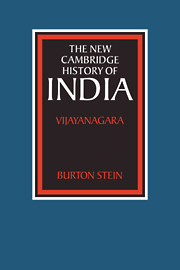Crossref Citations
This Book has been
cited by the following publications. This list is generated based on data provided by Crossref.
Price, Pamela G.
1991.
Acting in public versus forming a public: Conflict processing and political mobilization in nineteenth century South India.
South Asia: Journal of South Asian Studies,
Vol. 14,
Issue. 1,
p.
91.
Stein, Burton
1991.
De la royauté à l’État dans le monde indien.
p.
217.
Talbot, Cynthia
1992.
A revised view of ‘traditional’ India: Caste, status, and social mobility in medieval Andhra.
South Asia: Journal of South Asian Studies,
Vol. 15,
Issue. 1,
p.
17.
Brittlebank, Kate
1993.
Curiosities, conspicuous piety and the maker of time. some aspects of kingship in eighteenth‐century South India.
South Asia: Journal of South Asian Studies,
Vol. 16,
Issue. 2,
p.
41.
Zagarell, Allen
1995.
Hierarchy and Heterarchy: The Unity of Opposites.
Archaeological Papers of the American Anthropological Association,
Vol. 6,
Issue. 1,
p.
87.
Chibber, Vivek
1998.
Breaching the nadu: Lordship and economic development in pre‐colonial South India.
Journal of Peasant Studies,
Vol. 26,
Issue. 1,
p.
1.
Sinopoli, Carla M.
1998.
Identity and Social Action among South Indian Craft Producers of the Vijayanagara Period.
Archaeological Papers of the American Anthropological Association,
Vol. 8,
Issue. 1,
p.
161.
Sinopoli, Carla M.
2003.
The Political Economy of Craft Production.
Hauser‐Schäublin, Brigitta
2005.
TEMPLE AND KING: RESOURCE MANAGEMENT, RITUALS AND REDISTRIBUTION IN EARLY BALI.
Journal of the Royal Anthropological Institute,
Vol. 11,
Issue. 4,
p.
747.
Eaton, Richard M.
2005.
A Social History of the Deccan, 1300–1761.
2005.
A Social History of the Deccan, 1300–1761.
p.
78.
Rao, Nagendra
2007.
Dominators or Dominated? Muslim Traders in South Western India.
Comparative Islamic Studies,
Vol. 1,
Issue. 2,
p.
225.
Fischel, Roy S.
2016.
The Encyclopedia of Empire.
p.
1.
Ginn, Geoffrey
and
Spearritt, Peter
2016.
The Encyclopedia of Empire.
p.
1.
Bridges, Elizabeth J.
2016.
The Encyclopedia of Empire.
p.
1.
Singh, Manager Rajdeo
2019.
Microstructural studies of composite Mughal period cannons of Daulatabad Fort, India, by electron backscattered diffraction and scanning electron microscopy.
X-Ray Spectrometry,
Vol. 48,
Issue. 1,
p.
29.
Malik, Nadeem
2025.
Secular and Religious Politics in Pakistan, India, and Bangladesh.
p.
19.



